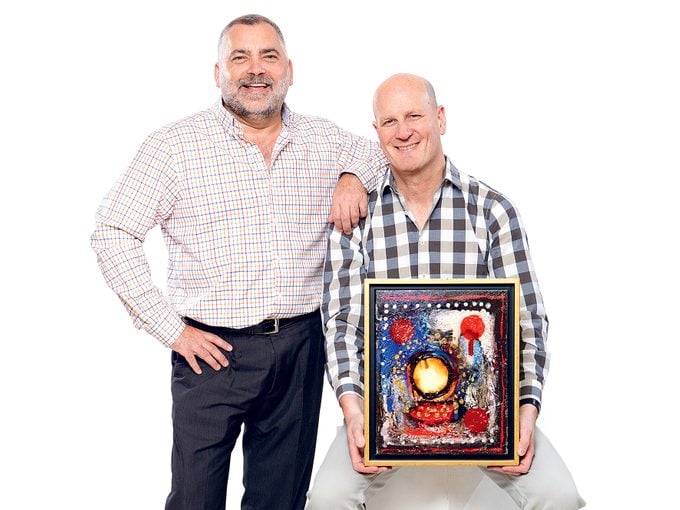Great Canadians: Art for Healing
With Art for Healing, Montrealers Gary Blair and Earl Pinchuk are humanizing the hospital experience.
 In 2001, when Earl Pinchuk was 39 years old, he took a year off from his family’s comforter-manufacturing business to do what he really loved: work at a contemporary art gallery. On an average day, he would scout a studio or two, viewing a couple hundred works. Then he would meet his partner, Gary Blair, and head up the hill leading from downtown Montreal to the Royal Victoria Hospital, where their friend Yves was dying of HIV-related complications. The couple had filled the room with memories of home: photos of Yves’s dogs, potted plants, a favourite bedspread. But they hadn’t thought about the walls.
In 2001, when Earl Pinchuk was 39 years old, he took a year off from his family’s comforter-manufacturing business to do what he really loved: work at a contemporary art gallery. On an average day, he would scout a studio or two, viewing a couple hundred works. Then he would meet his partner, Gary Blair, and head up the hill leading from downtown Montreal to the Royal Victoria Hospital, where their friend Yves was dying of HIV-related complications. The couple had filled the room with memories of home: photos of Yves’s dogs, potted plants, a favourite bedspread. But they hadn’t thought about the walls.
“When it was all over,” says Blair, “it hit us that our friend, an artist, had died staring at a blank wall.” Montreal didn’t lack contemporary art galleries, the men realized. But it was missing art in places where people most needed inspiration and comfort: hospitals and health care facilities.
Within six months, Blair and Pinchuk had an appointment with the pediatric task force at the Montreal Children’s Hospital. With $8,000 in hand, raised at Pinchuk’s 40th birthday party that February, they proposed a simple plan: their new foundation, Art for Healing, would buy 100 high-quality reproductions from a graphics company and donate them to the hospital. In January 2003, the first three pieces-featuring cartoon safari animals and children holding hands-went up in hematology. Soon after came the rooms of the permanent residents, kids who, due to the severity of their conditions or family circumstances, lived at the hospital. All but one of the seven patients asked for outdoor scenes.
In the 13 years since that inaugural installation, the couple has spent the bulk of their time promoting the therapeutic value of art. (Blair, who owns a communications company, devotes evenings and weekends to the foundation; Pinchuk became its sole staffer in 2006.) Art for Healing, now in 76 public institutions, has moved on from reproductions. More than 10,000 donations of original work by 400 artists, such as Betty Goodwin, Kent Monkman and Marc Séguin, hang in rehabilitation centres, cardiac institutes, mental-health hospitals and other facilities across the country.
Each health complex has specific needs. When catering to children, for example, there’s to be no nudity or scary animals; people in palliative care tend to prefer abstracts.
One of the organization’s most fruitful collaborations has been with the Donald Berman Maimonides Geriatric Centre in Montreal’s Côte Saint-Luc neighbourhood. Art for Healing curated the entire seven-storey building, contributing 1,200 pieces in total. “In 2006, we were installing historical photographs of the city’s Jewish community,” says Pinchuk, “and I had a feeling they might jog the memory of some residents suffering from dementia.” He was right: the men were approached by a woman who pointed out familiar sites in the series to them-and were later told by a doctor that she hadn’t spoken in six months.
While some viewers are brought out of their shell, others find comfort in contemplation. A decade ago, Maria D’Andrea was a regular at the Children’s Hospital: her 13-year-old, Sophie, had debilitating shoulder pain due to a benign tumour. One day, while waiting for MRI results, the pair wandered down an unfamiliar hallway. “All of a sudden, we spotted beautiful landscapes by Emily Carr. I told my daughter a bit about the artist, and we enjoyed the paintings together. For a few minutes, they took us away from all the anxiety and stress.” Today, Sophie, 23, is studying to become an art therapist.
“As humans, we spend a vast amount of time and resources trying to beautify our homes to create a grounding environment,” says Blair. “Art for Healing extends that practice into the places where we feel most in need of nurturing.”
Related features:
Luke Anderson, Trailblazer
Saving Syria-One Student at a Time
Hearts & Hammers



